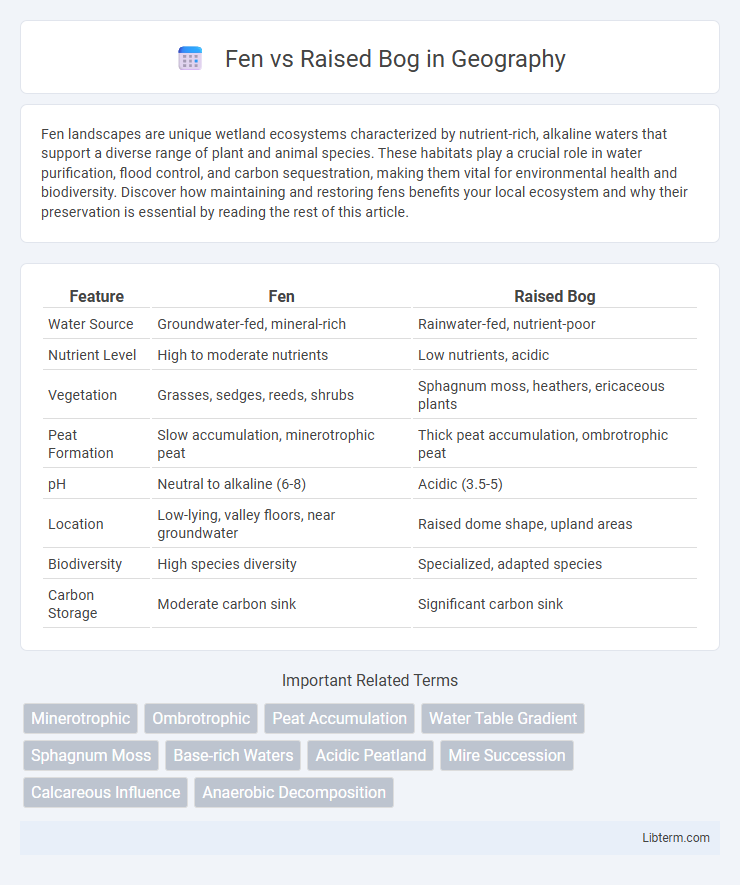Fen landscapes are unique wetland ecosystems characterized by nutrient-rich, alkaline waters that support a diverse range of plant and animal species. These habitats play a crucial role in water purification, flood control, and carbon sequestration, making them vital for environmental health and biodiversity. Discover how maintaining and restoring fens benefits your local ecosystem and why their preservation is essential by reading the rest of this article.
Table of Comparison
| Feature | Fen | Raised Bog |
|---|---|---|
| Water Source | Groundwater-fed, mineral-rich | Rainwater-fed, nutrient-poor |
| Nutrient Level | High to moderate nutrients | Low nutrients, acidic |
| Vegetation | Grasses, sedges, reeds, shrubs | Sphagnum moss, heathers, ericaceous plants |
| Peat Formation | Slow accumulation, minerotrophic peat | Thick peat accumulation, ombrotrophic peat |
| pH | Neutral to alkaline (6-8) | Acidic (3.5-5) |
| Location | Low-lying, valley floors, near groundwater | Raised dome shape, upland areas |
| Biodiversity | High species diversity | Specialized, adapted species |
| Carbon Storage | Moderate carbon sink | Significant carbon sink |
Introduction to Fens and Raised Bogs
Fens and raised bogs are types of peatland ecosystems characterized by waterlogged conditions and organic soil accumulation. Fens receive nutrient-rich groundwater, supporting diverse plant communities including sedges and brown mosses, while raised bogs are rain-fed, acidic environments dominated by sphagnum mosses. The distinction in water sources and vegetation results in contrasting nutrient levels and ecological functions within these wetland habitats.
Defining Wetland Ecosystems
Fens and raised bogs are distinct types of peat-forming wetland ecosystems characterized by their water sources and nutrient availability. Fens receive mineral-rich groundwater, supporting diverse plant species and higher nutrient levels, while raised bogs rely solely on precipitation, resulting in acidic, nutrient-poor conditions dominated by sphagnum moss. These differences influence their ecological functions, carbon storage capacities, and habitat biodiversity, making fen versus raised bog classification essential in wetland conservation and management.
Formation Processes: Fen vs Raised Bog
Fens form in mineral-rich groundwater areas where slow-moving water supplies nutrients, supporting diverse plant communities, while raised bogs develop in waterlogged, acidic conditions with low nutrient availability, accumulating peat primarily from sphagnum moss. Fen formation involves groundwater flow that maintains a neutral to alkaline pH, promoting sedge and grass growth, whereas raised bogs rise above the water table due to peat buildup, creating ombrotrophic conditions dependent solely on precipitation. The key distinction lies in fen development through groundwater influence versus raised bog evolution through rainwater accumulation and peat thickening.
Key Differences in Hydrology
Fens receive mineral-rich groundwater that maintains a higher pH, supporting diverse plant communities, while raised bogs rely primarily on precipitation, resulting in acidic, nutrient-poor conditions. The water table in fens is typically stable due to constant groundwater input, whereas raised bogs have a perched water table influenced by rainwater accumulation. This hydrological distinction drives differences in peat composition, vegetation, and ecosystem dynamics between the two wetland types.
Vegetation and Biodiversity Comparison
Fens support diverse vegetation including sedges, grasses, and wildflowers adapted to nutrient-rich, slightly alkaline conditions, fostering high biodiversity with various fen-specialist plants and invertebrates. Raised bogs feature sphagnum moss-dominated vegetation thriving in nutrient-poor, acidic environments, promoting unique bog-specific species like cotton grass and heather. The contrast in water chemistry and nutrient availability shapes distinct ecosystems, making fens generally richer in plant diversity, while raised bogs provide critical habitats for specialized acidophilic organisms.
Soil Composition and Peat Accumulation
Fens feature mineral-rich, alkaline soils derived from groundwater, promoting diverse vegetation and slow peat accumulation with moderate decomposed organic matter. Raised bogs develop acidic, nutrient-poor soils primarily from rainwater, leading to thick layers of highly decomposed peat with low mineral content. Peat in fens contains higher mineral sediments, while raised bog peat is predominantly sphagnum moss-dominated, contributing to stronger carbon sequestration.
Ecological Functions and Benefits
Fens and raised bogs both serve crucial ecological functions in wetland ecosystems, with fens acting as nutrient-rich habitats that support diverse plant and animal species through groundwater-fed mineral inputs. Raised bogs provide significant carbon sequestration benefits by accumulating peat from sphagnum moss, thereby mitigating climate change. Both wetland types enhance water regulation and filtration, maintaining water quality and reducing flood risks.
Geographic Distribution and Examples
Fens and raised bogs exhibit distinct geographic distributions primarily influenced by climate and topography, with fens commonly found in temperate and boreal regions where groundwater supplies create nutrient-rich, alkaline conditions, such as the extensive fenlands in the British Isles and the Great Lakes region of North America. Raised bogs typically occur in cool, humid climates featuring low nutrient availability and acidic environments, exemplified by the extensive raised bog complexes in Northern Europe, including Ireland's Bog of Allen and Finland's extensive peatlands. These wetland types serve as crucial carbon sinks and biodiversity hotspots, with their distribution shaped by hydrology and atmospheric deposition patterns.
Human Impacts and Conservation Challenges
Fens and raised bogs face significant human impacts including drainage for agriculture, peat extraction, and urban development, leading to habitat degradation and loss of biodiversity. Conservation challenges involve restoring hydrological regimes disrupted by drainage, controlling invasive species, and balancing land use with ecosystem preservation. Effective protection requires site-specific management plans incorporating hydrological restoration, monitoring, and community engagement to sustain these peatland ecosystems.
Future Outlook for Fens and Raised Bogs
Fens and raised bogs face differing future prospects due to climate change and land use pressures, with fens experiencing increased threats from drainage and nutrient input that compromise their unique biodiversity and carbon storage capabilities. Raised bogs are vulnerable to desiccation and peat degradation, which may accelerate greenhouse gas emissions and reduce habitat quality. Conservation efforts emphasizing hydrological restoration and protection are critical for maintaining the ecological integrity and carbon sequestration functions of both fen and raised bog ecosystems in changing environmental conditions.
Fen Infographic

 libterm.com
libterm.com